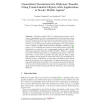141 search results - page 3 / 29 » Oblivious Transfer and Linear Functions |
IACR
2011
12 years 9 months ago
2011
We aim at constructing adaptive oblivious transfer protocols, enjoying fully simulatable security, from various well-known assumptions such as DDH, d-Linear, QR, DCR, and LWE. To t...
ISW
2005
Springer
14 years 3 months ago
2005
Springer
Abstract. We propose a one-round 1-out-of-n computationally-private information retrieval protocol for -bit strings with low-degree polylogarithmic receivercomputation, linear send...
FC
2008
Springer
13 years 11 months ago
2008
Springer
Oblivious transfer (OT) is a fundamental primitive used in many cryptographic protocols, including general secure function evaluation (SFE) protocols. However, interaction is a pri...
CRYPTO
2007
Springer
14 years 1 months ago
2007
Springer
Oblivious transfer (OT) is an essential building block for secure multiparty computation when there is no honest majority. In this setting, current protocols for n 3 parties requ...
ICICS
2005
Springer
14 years 3 months ago
2005
Springer
Private itemset support counting (PISC) is a basic building block of various privacy-preserving data mining algorithms. Briefly, in PISC, Client wants to know the support of her i...


